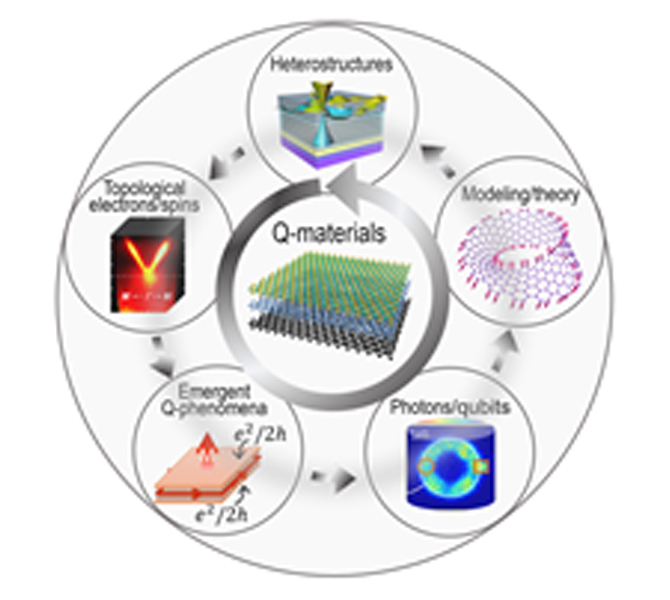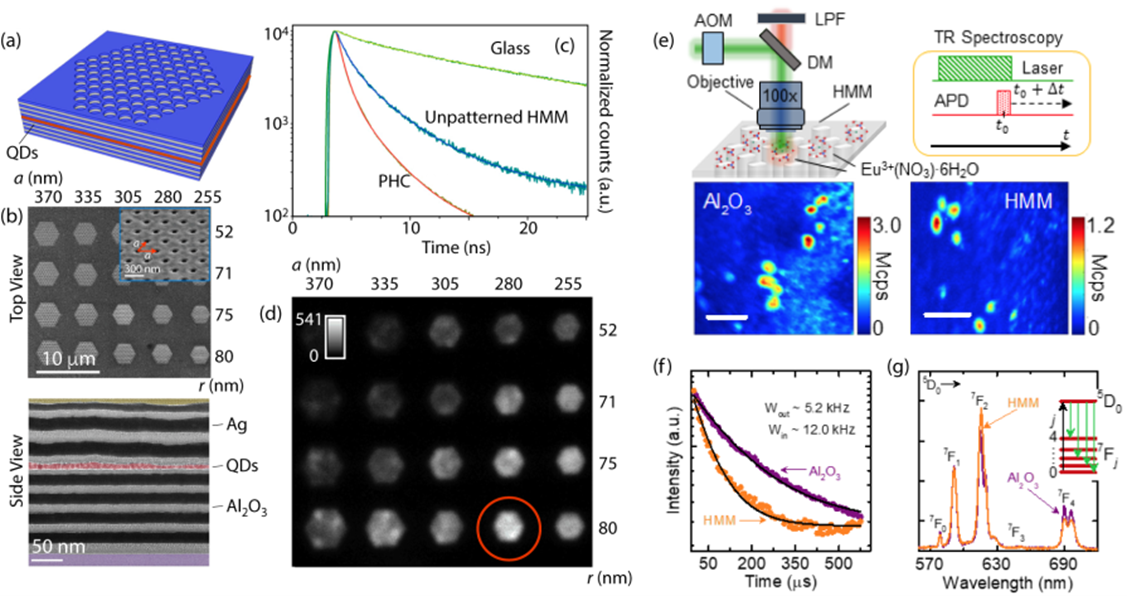Emergent Quantum Materials and Functions
Leader: Lia Krusin-Elbaum
Team: Krusin-Elbaum, Gayen, Ghaemi, Khanikaev, Menon, Meriles, Park, Tamargo.
Subproject 1 aims to create a core of excellence in Materials Science and Engineering of two-dimensional (2D, surfaces and interfaces) systems where band topology and strong electron correlations emerge, creating new concepts, functions and quantum phenomena for the next-generation quantum technologies. Zero-dimensional (0D, localized defects) systems (rare-earth ions in host matrices) will be utilized as platforms for implementing spin qubits that circumvent the limitations of current schemes. The Subproject research aligns directly with the national priority of “Leading the Next Quantum Revolution”.

Cluster 1. Magnetic topological insulators. Topological insulators (TIs) and superconductors1 belong to a remarkable class of quantum solids where distinct electronic band structure with the relativistic topologically-protected Dirac surface states undergird novel quantum phenomena that include quantized anomalous Hall (QAH) and spin Hall effects2,3, and dissipation-free transport of charge associated with such states. The proposal builds on our recent realization of a new topological intrinsic magnetic superlattice structure in bulk crystals of MnBi2Te4 septuple layers (SL) and the topological insulator Bi2Te3 quintuple layers4 (QL) in which we realized a robust high-temperature QAH regime. We propose to grow related intrinsic magnetic superlattice materials with spacing that can be controlled on-demand to achievedissipationless transport in QAH and axion insulator statesat even higher temperatures. This will be realized 1) by bulk growth and 2) by molecular beam epitaxy (MBE).5 The efforts will be guided by theory, and through studies of transport and magnetization, ARPES and STM.

Intrinsic magnetic topological superlattices at CCNY. (a) Bulk crystalline ordered (MnBi2Te4)(Bi2Te3)4 superlattice imaged by scanning TEM (left) and energy dispersive X-ray (right).4 Outset: Crystal structure of MnBi2Te4 septuple layer SL. (b) Calculated bandstructure of QL-layered Bi2Te3 (left) and SL/4QL/SL superlattice (right) structure. (c) Magnetization M(T) (red) measured in a -100 Oe field. Anomalous Hall conductance (T) (blue) onsets at TC~ 13 K and begins to approach the quantized value e2/h from about 7 K on cooling. (d) We observe an e2/h quantization plateau4 in Hall conductance Gyx vs. gate voltage Vg at zero field when the Fermi level EF is aligned with Dirac gap D (red circles).
Cluster 2. Twisted bilayers and other geometries. An exciting new way of tuning the bandstructure by creating twist-induced periodic surface moiré potentials6 has recently transpired as a path to fascinating emergent quantum behaviors. The imposed moiré superlattices in bilayers can lead to flat electronic bands, thereby promoting strongly correlated phases, such as ferromagnetism and superconductivity. We propose to explore twisted TI/TI stacks where flattened bands and the correlated states were predicted7at small twist angles, as well as h-BN/TI, h-BN/QAH, and our magnetic TI twisted stacks, where we expect new spin textures, including topological skyrmions, to emerge. The effect of strength of periodic potentials induced on TI surfaces will be investigated by engineering patterned or corrugated substrates8 or electrostatic gating control. The emergent quantum states will be investigated by ARPES, STM, and charge transport.
Cluster 3. Designing rare-earth spin qubits in quasi-2D hosts. Solid-state quantum registers formed by interacting electron and nuclear spins amenable to high-fidelity state manipulation and readout provide a promising architecture for quantum technologies, including local information processing and storage, error correction, and long-distance state transmission via photon emission. Pioneering work has propelled defect centers in diamond9 and other wide-bandgap semiconductors10 as reference platforms for optimal chip-integrated solid-state quantum processors. We will introduce an alternate route to solid-state qubit research that capitalizes on the ‘atom-like’ spin and optical properties of spinful rare-earth (RE) ions. Our preliminary results obtained by the implantation of Ce atoms in h-BN flakes support the notion of RE ions as nearly-ready-to-use spin qubits. We propose to use Ce, Eu and Er dopants in hosts such as GaN, AlN, Ga2O3 and SiC to implement optical and spin manipulation schemes to develop hybrid platforms optimized for quantum technologies.

Photonic hypercrystal (PHC) structures. (a) Schematics of the Hyperbolic Metamaterials (HMM)/PHC structure. (b) Top and cross-sectional SEM images of an array of different HMM/PHC structures; r and a respectively indicate the hole radius and spacing in the PHC. (c) Lifetime kinetics of QDs in different environments; the spontaneous emission rate enhancement as compared to glass is about 20-fold. (d) Confocal image of the structures in (b) as seen from the top. At best (red circle) the QD photon count is 2000-fold stronger than in bulk glass. (e) Confocal microscopy of Eu-based nanoparticles on an Al2O3 substrate (left image), or on hyperbolic metamaterials (HMM, right image). (f) The HMM reduces the lifetime of the Eu emitters. (g) Spectroscopy of Eu emitters in the above particles.
References:
- X.-L. Qi and S.-C. Zhang, Topological insulators and superconductors, Rev. Mod. Phys. 83, 1058 (2011).
- R. Yu, W. Zhang, H.-J. Zhang, S.-C. Zhang, X. Dai, and Z. Fang, Quantized anomalous Hall effect in magnetic topological insulators, Science 329, 61 (2010).
- X.-L. Qi and S.-C. Zhang, The quantum spin Hall effect and topological insulators, Physics Today 63, 33 (2010).
- H. Deng, Z. Chen, A. Wo o , M. Konczykowski, K. Sobczak, J. Sitnicka, I. V. Fedorchenko, J. Borysiuk, T. Heider, . Pluci ski, K. Park, A. B. Georgescu, J. Cano and L. Krusin-Elbaum, High-temperature quantum anomalous Hall regime in a MnBi2Te4/Bi2Te3 superlattice. Nature Phys.. (2020) (published on line)
- I. Levy, T. A. Garcia, S. Shafique, and M. C. Tamargo, Reduced twinning and surface roughness of Bi2Se3 and Bi2Te3 layers grown by molecular beam epitaxy on sapphire substrates, J. Vac. Sci. Technol. B 36, 02D107-1 (2018).
- R. Ribeiro-Palau, C. Zhang, K. Watanabe, T. Taniguchi, J. Hone, and C.R. Dean, Twistable electronics with dynamically rotatable heterostructures, Science 361, 690 (2018).
- L. Balents, C. R. Dean, D. K. Efetov, and A. F. Young, Superconductivity and strong correlations in moiré flat bands, Nature Phys. 16, 725 (2020).
- M. S. Claro, I. Levy, T. A. Garcia, A. Gangopadhyay, D. J. Smith, and M. C. Tamargo, Growth Habits of Bismuth Selenide (Bi2Se3) Layers and Nanowires over Stranski–Krastanov Indium Arsenide Quantum Dots, Cryst. Growth Des. 19, 6989 (2019).
- B. C. Rose, D. Huang, Z-H. Zhang, A. M. Tyryshkin, S. Sangtawesin, S. Srinivasan, L. Loudin, M. L. Markham, A.M. Edmonds, D.J. Twitchen, S. A. Lyon, and N.P. de Leon, Observation of an environmentally insensitive solid-state spin defect in diamond, Science 361, 60 (2018).
- W. F. Koehl, B. B. Buckley, F. J. Heremans, G. Calusine, and D. D. Awschalom, Room temperature coherent control of defect spin qubits in silicon carbide, Nature 479, 84 (2011).